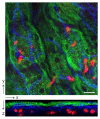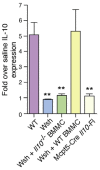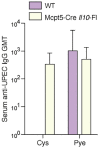Why Serological Responses during Cystitis are Limited
- PMID: 26907352
- PMCID: PMC4810140
- DOI: 10.3390/pathogens5010019
Why Serological Responses during Cystitis are Limited
Abstract
The high frequency of urinary tract infections (UTIs), some of which appear to be endogenous relapses rather than reinfections by new isolates, point to defects in the host's memory immune response. It has been known for many decades that, whereas kidney infections evoked an antibody response to the infecting bacteria, infections limited to the bladder failed to do so. We have identified the existence of a broadly immunosuppressive transcriptional program associated with the bladder, but not the kidneys, during infection of the urinary tract that is dependent on bladder mast cells. This involves the localized secretion of IL-10 and results in the suppression of humoral immune responses in the bladder. Mast cell-mediated immune suppression could suggest a role for these cells in critically balancing the needs to clear infections with the imperative to prevent harmful immune reactions in the host.
Keywords: cystitis; defects in memory response; mast cells; recurrent UTI; serology.
Figures






Similar articles
-
Mast cell interleukin-10 drives localized tolerance in chronic bladder infection.Immunity. 2013 Feb 21;38(2):349-59. doi: 10.1016/j.immuni.2012.10.019. Epub 2013 Feb 15. Immunity. 2013. PMID: 23415912 Free PMC article.
-
Time course and host responses to Escherichia coli urinary tract infection in genetically distinct mouse strains.Infect Immun. 1998 Jun;66(6):2798-802. doi: 10.1128/IAI.66.6.2798-2802.1998. Infect Immun. 1998. PMID: 9596750 Free PMC article.
-
Bacterial characteristics of importance for recurrent urinary tract infections caused by Escherichia coli.Dan Med Bull. 2011 Apr;58(4):B4187. Dan Med Bull. 2011. PMID: 21466767 Review.
-
Can a Silent Kidney Infection or Genetic Predisposition Underlie Recurrent UTIs?Medscape Womens Health. 1996 Sep;1(9):6. Medscape Womens Health. 1996. PMID: 9746644
-
Urinary tract infections in women.Can J Urol. 2001 Jun;8 Suppl 1:6-12. Can J Urol. 2001. PMID: 11442991 Review.
Cited by
-
Elevated urine IL-10 concentrations associate with Escherichia coli persistence in older patients susceptible to recurrent urinary tract infections.Immun Ageing. 2019 Jul 11;16:16. doi: 10.1186/s12979-019-0156-9. eCollection 2019. Immun Ageing. 2019. PMID: 31338112 Free PMC article.
-
IL-10 in Mast Cell-Mediated Immune Responses: Anti-Inflammatory and Proinflammatory Roles.Int J Mol Sci. 2021 May 7;22(9):4972. doi: 10.3390/ijms22094972. Int J Mol Sci. 2021. PMID: 34067047 Free PMC article. Review.
-
Loss of NLRP3 increases bacterial cystitis via IRAKM.Transl Androl Urol. 2022 Feb;11(2):268-276. doi: 10.21037/tau-22-67. Transl Androl Urol. 2022. PMID: 35280657 Free PMC article.
-
Anti-Inflammatory Action and Molecular Mechanism of Fucoidan Against Cystitis Glandularis.Food Sci Nutr. 2024 Nov 4;12(12):10255-10261. doi: 10.1002/fsn3.4560. eCollection 2024 Dec. Food Sci Nutr. 2024. PMID: 39723046 Free PMC article.
-
Bladder-draining lymph nodes support germinal center B cell responses during urinary tract infection in mice.Infect Immun. 2023 Nov 16;91(11):e0031723. doi: 10.1128/iai.00317-23. Epub 2023 Oct 26. Infect Immun. 2023. PMID: 37882531 Free PMC article.
References
-
- Patton J.P., Nash D.B., Abrutyn E. Urinary tract infection: Economic considerations. Med. Clin. N. Am. 1991;75:495–513. - PubMed
Publication types
Grants and funding
LinkOut - more resources
Full Text Sources
Other Literature Sources

